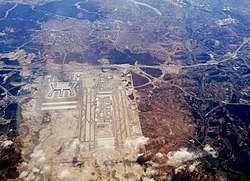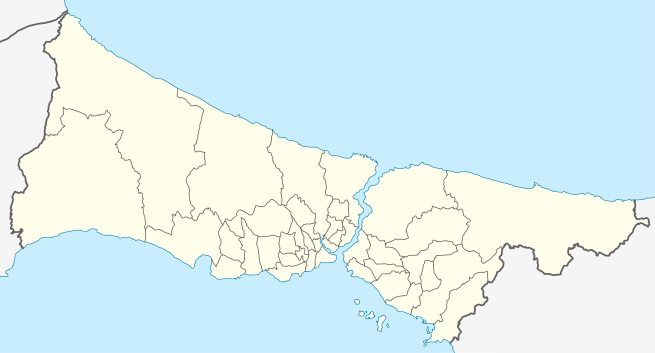Istanbul New Airport
| Istanbul New Airport İstanbul Yeni Havalimanı | |||||||||||||||||||||||
|---|---|---|---|---|---|---|---|---|---|---|---|---|---|---|---|---|---|---|---|---|---|---|---|
 Aerial view of the airport in September 2018. | |||||||||||||||||||||||
| Summary | |||||||||||||||||||||||
| Airport type | Public | ||||||||||||||||||||||
| Owner | General Directorate of State Airports (DHMİ) | ||||||||||||||||||||||
| Operator | IGA (Istanbul Grand Airport) Havalimanı İşletmesi A.Ş. | ||||||||||||||||||||||
| Serves | Istanbul, Turkey | ||||||||||||||||||||||
| Location | Arnavutköy, Istanbul | ||||||||||||||||||||||
| Opened | 29 October 2018 (expected) | ||||||||||||||||||||||
| Time zone | TRT (UTC+03:00) | ||||||||||||||||||||||
| Elevation AMSL | 325 ft / 99 m | ||||||||||||||||||||||
| Coordinates | 41°16′31.00″N 28°45′07.00″E / 41.2752778°N 28.7519444°ECoordinates: 41°16′31.00″N 28°45′07.00″E / 41.2752778°N 28.7519444°E | ||||||||||||||||||||||
| Website |
www | ||||||||||||||||||||||
| Map | |||||||||||||||||||||||
 Istanbul New Airport Location of airport in Istanbul  Istanbul New Airport Istanbul New Airport (Turkey)  Istanbul New Airport Istanbul New Airport (Europe) | |||||||||||||||||||||||
| Runways | |||||||||||||||||||||||
| |||||||||||||||||||||||
| Statistics | |||||||||||||||||||||||
| |||||||||||||||||||||||
Istanbul New Airport (IATA: ISL, ICAO: LTFM)[1][2] (Turkish: İstanbul Yeni Havalimanı) is an international airport under construction in the Arnavutköy district on the European side of Istanbul, Turkey.
The airport was planned as the largest airport in the world[3] with a 150 million annual passenger capacity in its last planned expansion stage, while remaining upgradable to handle 200 million annual passengers if required in the future.[4][5] It will be the third international airport to be built in Istanbul after Atatürk Airport and Sabiha Gökçen Airport. Atatürk Airport will be closed down for scheduled passenger flights once the new airport is fully operational;[6] and its IATA code IST will be transferred to the new airport.[1][2][7]
As of August 2018, 94% of the first stage of construction was completed.[8] The inauguration of the airport is planned to take place on 29 October 2018. It was reported that the first test landing at the airport would take place on February 26, 2018; however the first landing took place on 20 June 2018.[5] Testing of navigational and electronic systems with DHMİ aircraft began on 15 May 2018.[9]
According to the General Directorate of State Airports (DHMİ), the opening ceremony is scheduled to take place on 29 October 2018. However, the transfer of operations from Atatürk Airport will commence on 30 or 31 December 2018 at the earliest.[10]
Background
Atatürk Airport, Istanbul's current main airport, is located in the Yeşilköy neighbourhood of the Bakırköy district and is surrounded by urban Istanbul. Additionally, there is an increasing problem of air traffic congestion. Atatürk Airport is one of the busiest airports in Europe. Since 2013, it has ranked among the five busiest airports in Europe by passenger traffic.
There is no space to build an additional runway on the Atatürk Airport site, as the airport is surrounded on all sides. Because of the limited capacity, the Turkish Airport Authority does not allow additional cargo or charter flights to the airport. Due to a lack of slot capacity and parking spaces, some of Turkish Airlines' aircraft are based in Sabiha Gökçen Airport. Sabiha Gökçen Airport itself is already at maximum terminal capacity of 25 million passengers, and handled 28 million passengers in 2015 after posting traffic growth rates averaging over 20% a year since 2013.
In 2015 and 2016, the two Istanbul airports handled almost 90 million passengers, with more than 95 million passengers in 2017.[11] In terms of area airports, the six London-area airports serve more than 150 million passengers a year, while the three Paris-area airports serve around 100 million passengers a year.
Location
The new airport is constructed at the intersection of roads to Arnavutköy, Göktürk, and Çatalca, north of the Istanbul city centre and between the Black Sea coast towns of Yeniköy, Tayakadın and Akpınar. The construction zone is a 7,659-hectare region near Lake Terkos. Some 6,172 hectares of this area was state-owned forest. The distance between Istanbul New Airport and Atatürk Airport is approx. 35 km (22 mi) as the crow flies. The area encompasses old open-pit coal mines, which are to be filled up with soil.[12] The new airport will eventually be linked by several lines of the Istanbul Metro: one starting from Gayrettepe station on the new M11 line, another from Halkalı on the Marmaray rail line.[13]
According to the Environmental Impact Assessment (ÇED) report published in April 2013, there were a total of 2,513,341 trees in the area and 657,950 of them would need to be cut indispensably, while 1,855,391 trees would be moved to new places. However, the Ministry of Forest and Water Management said the exact number of trees cut and moved will only be revealed after construction is complete.[12]
Project
.png)
The tender for construction and operation of the facility until 2030 was held on May 3, 2013.[4] The project is made up of four construction stages. If all stages are completed, the airport will reach a capacity of 150 million passengers, which would have made it the biggest in the world at the time of planning. The first stage of construction was planned to finish within 42 months of the handover of the land. The total project cost is expected to be approximately €7 billion, excluding financing costs. The construction and operation consortium has been guaranteed 342 million passengers in 12 years by the government.
The design team was lead by London-based Grimshaw.[14] and also included the Norway-based Nordic Office of Architecture and London studio Haptic.
At the bidding session on May 3, 2013, only four out of fifteen Turkish and two foreign companies that were qualified as bidders showed up. The Turkish joint venture consortium of Cengiz-Kolin-Limak-Mapa-Kalyon won the tender, and were obliged to pay the government €26.142 billion including value-added tax for a 25-year lease starting from 2018. The completion date of the construction's first stage was officially set for 2018 - 42 months after the finalization of the tender's approval.[12]
The groundbreaking ceremony took place on 7 June 2014,[15] yet construction only started in May 2015 after official handover of the land.[7]
Project stages
The construction of the airport is set to take place in several stages, expanding the airport and its facilities over time:[4][16][17][18]
First stage
- A main terminal with a total passenger capacity of 90 million, with an area of 1,300,000 m2 (14,000,000 sq ft)
- Second terminal building with an area of 170,000 m2 (1,800,000 sq ft)
- 88 aircraft jet bridges
- Indoor car-park with 12,000 vehicles capacity
- 2 independent runways
- 8 parallel taxiways
- Approximately 4,000,000 m2 (43,000,000 sq ft) of apron space
- 3 technical blocks
- 1 air traffic control tower
- VIP Lounge
- Cargo and general aviation terminals
- Other services including hospitals, prayer rooms, convention centres, hotels etc.
Second stage
- 1 runway
- 3 parallel taxiways
Third stage
- Terminal with a capacity of 30 million annual passengers and an area of 500,000 m2 (5,400,000 sq ft)
- 1 runway
- 1 parallel taxiway
- Additional apron area
Fourth stage
- A terminal with a capacity of 30 million passengers and an area of 340,000 m2 (3,700,000 sq ft)
- 1 runway
Upon completion (estimated before 2030)
- 6 runways
- 16 taxiways
- 150 million annual passenger capacity – expandable to 200 million[19]
- 1,500,000 m2 (16,000,000 sq ft) indoor area
- 165 aircraft jet bridges
- 4 terminal buildings, with rail access between terminals
- 3 technical blocks
- 1 air traffic control tower
- 8 ramp control towers
- A 6,500,000 m2 (70,000,000 sq ft) apron with 500 aircraft parking capacity
- VIP Lounges
- Cargo and general aviation terminals
- State palace
- Indoor and outdoor parking with a capacity of approx. 70,000 cars
- Aviation medical center
- Aircraft rescue and firefighting stations
- Garage buildings
- Hotels
- Convention centers
- Power plants
- Water treatment and waste facilities
Airlines and Destinations
Turkish Airlines announced that they would fly flights to Ankara, Antalya, Izmir, North Nicosia and Baku out of Istanbul New Airport beginning 29 October 2018.[20]
Controversies
The Turkish Chamber of Environmental Engineers (ÇMO) took the project tender to court on grounds that the project violated the existing legislation for the preparation of the Environmental Impact Assessment (ÇED) report.[12] In February 2014, an Istanbul administrative court ordered construction of the airport to be suspended.[21] However, the groundbreaking ceremony took place a few months later, on 7 June 2014.[15]
As of February 2018, the Turkish Ministry of Labour announced 27 fatalities during the construction of the airport. Local trade unions however speak of much higher figures with three to four fatalities per week. According to the Cumhuriyet daily newspaper, families of workers killed on site are being paid to remain silent about the incidents.[22]
A report that up to 400 workers had been killed during the construction of the airport prompted opposition MP Veli Ağbaba to submit a written questionnaire to the Turkish parliament on 13 February 2018.[23]
See also
References
- 1 2 Munyar, Vahap (2018-10-06). "7.5 milyar Euro'luk İGA, 29 Ekim'de 'ISL' koduyla açılıyor". Hürriyet (in Turkish). Archived from the original on 2018-10-07. Retrieved 2018-10-07.
- 1 2 (in Turkish)"Yeni havalimanı’nın IATA kodu IST, ICAO kodu LTFM"
- ↑ "Limak to construct new terminal at Kuwait International Airport".
- 1 2 3 "Dünyanın en büyük havalimanı İstanbul'a yapılıyor". Star. 2013-01-24. Retrieved 2013-01-24.
- 1 2 - "Istanbul Grand Airport to open in October 2018" (German) 6 October 2017
- ↑ https://www.cnnturk.com/turkiye/ucuncu-havalimani-acilinca-ataturk-havalimani-kapatilacak-mi
- 1 2 "Construction of new Istanbul airport officially starts under shadow of challenges, questions". 18 July 2015. Archived from the original on 2 August 2015. Retrieved 21 July 2015.
- ↑ "Yeni Havalimanı için DHMİ'ye başvuru yapıldı". www.airporthaber.com (in Turkish). 2018-08-06. Retrieved 2018-10-02.
- ↑ "3. Havalimanı'nın yüzde 90'ı tamamlandı". trthaber.com (in Turkish). 27 May 2018. Archived from the original on 1 July 2018. Retrieved 1 October 2018.
- ↑ "Kokpit.aero'nun dediği çıktı: İstanbul Yeni Havalimanı için taşınma tarihi açıklandı". www.kokpit.aero (in Turkish). 2018-10-05. Retrieved 2018-10-06.
- ↑ "Turkish Airport Traffic Statistics". DHMI Turkey. Retrieved 18 March 2016.
- 1 2 3 4 "Consortium wins Istanbul airport tender for 22.1 billion euros". Hürriyet Daily News. 2013-05-03. Retrieved 2013-05-03.
- ↑ "Turkey to build new metro lines for the third airport in Istanbul". Railway Pro. Retrieved 2017-03-29.
- ↑ Architects, Grimshaw. "Istanbul New Airport". grimshaw.global. Retrieved 2018-10-02.
- 1 2 Grundsteinlegung für Mega-Flughafen in Istanbul. welt.de, 7. Juni 2014; retrieved, 8 June 2014
- ↑ "Istanbul's third airport 71 pct completed". Daily Sabah. Retrieved 2017-11-10.
- ↑ "İGA - About the Construction". igairport.com. Retrieved 2018-03-27.
- ↑ "İGA - Aşamalar". www.igairport.com. Retrieved 2018-03-27.
- ↑ Ay, Hasan. "Havalimanı değil zafer anıtı". sabah.com.tr. Sabah. Retrieved 8 June 2014.
- ↑ "ℹ Attention to all our passengers! #TurkishAirlines". Twitter. Turkish Airlines. 12 October 2018. Retrieved 2018-10-15.
- ↑ "İstanbul court orders suspension of 3rd airport's construction". Today's Zaman. 2014-02-10. Archived from the original on 2014-02-26. Retrieved 2014-06-08.
- ↑ Güsten, Susanne (25 February 2018). "Staunen und Sterben auf dem neuen Mega-Flughafen in Istanbul" [Amazement and dying at the new mega-airport in Istanbul]. Augsburger Allgemeine (in German). Retrieved 26 February 2018.
- ↑ Boyacıoğlu, Hacer (14 February 2018). "Turkish government says 27 workers killed in Istanbul's third airport construction". Hürriyet. Retrieved 26 February 2018.
External links
![]()